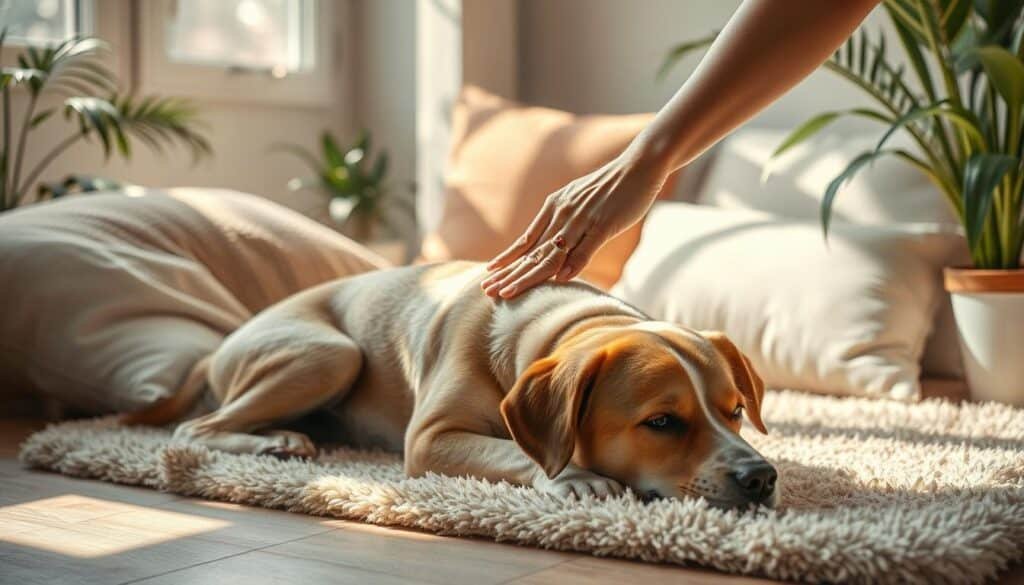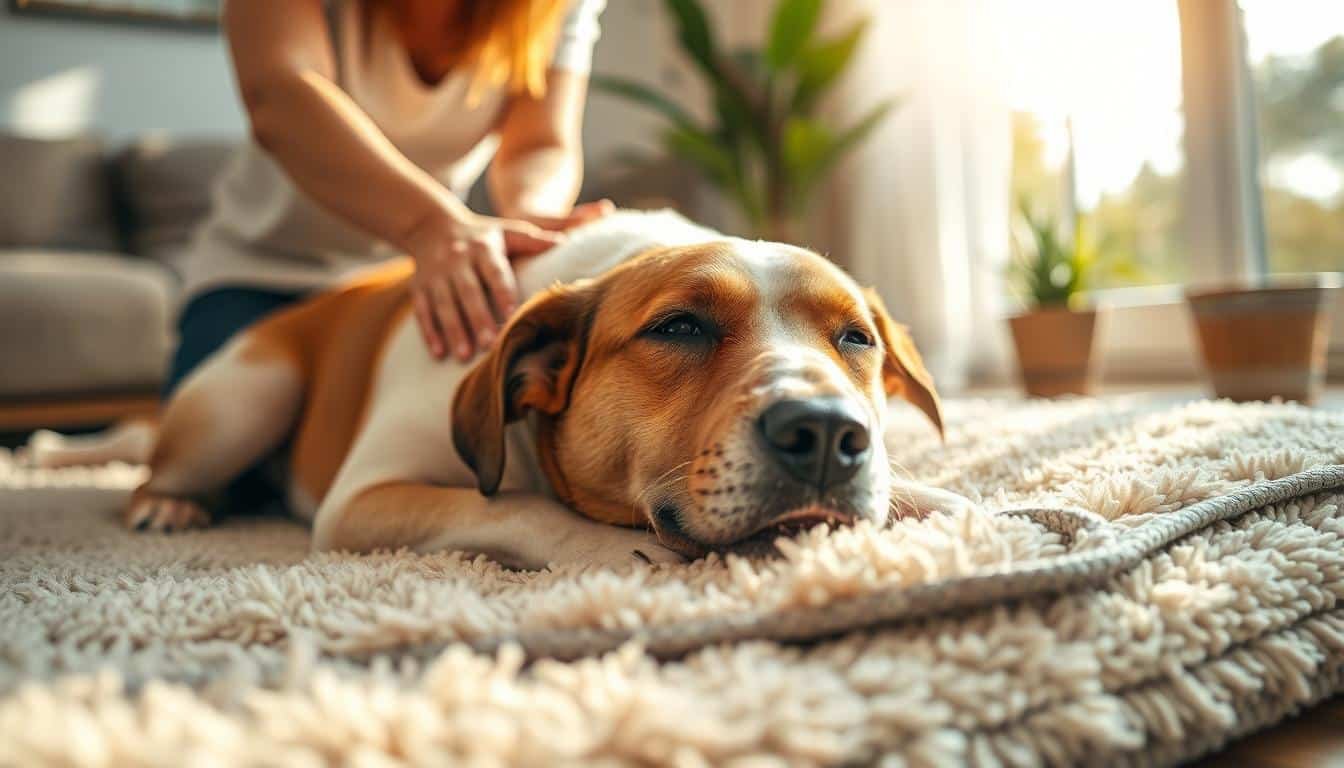I never thought I’d give my Golden Retriever, Max, a massage. But there I was, gently rubbing his fur. His eyes closed in bliss. It started when Max limped home from the dog park. I took him to the vet, who suggested canine massage therapy.
Studies show petting a dog can lower heart rate and blood pressure. Imagine a full-body massage1! A study with 527 dogs found massage improved their quality of life. It helped those with muscular injuries, arthritis, and other orthopedic conditions2.
But do dogs like massages? Most do, though high-energy pups might find it hard to sit still2. The key is to watch your dog’s body language and ensure they’re comfortable1. From puppies to seniors, all dogs can benefit from massage therapy. It promotes relaxation, reduces stress, and aids in rehabilitation13.
As I learned more about pet massage techniques, I found it’s not just about physical health. Massaging your dog can deepen your bond and teach them to view touch positively. This is valuable for future vet visits and grooming sessions23. It’s a win-win situation: your dog gets pampered, and you get to strengthen your connection. So, are you ready to give your furry friend a relaxing rub-down?
Key Takeaways
- Most dogs enjoy massages, which can lower heart rate and blood pressure.
- Canine massage therapy benefits dogs of all ages, from puppies to seniors.
- Massage can help with pain relief, rehabilitation, and stress reduction in dogs.
- Observing your dog’s body language is crucial during massage sessions.
- Regular massages can strengthen the bond between dogs and their owners.
- Professional canine massage therapists are available for specialized treatments.
- Basic massage techniques can be practiced at home to benefit your dog’s health.
Understanding Dog Behavior and Preferences
Dogs love relaxation massages4. As a dog owner, I’ve seen how they seek touch for comfort and bonding. This is the basis of canine massage therapy, a growing trend in pet care. It’s showing great results for dogs who enjoy affection5.
Why Dogs Seek Physical Touch
Dogs need physical contact for many reasons. Pet parents use massages to help their dogs relax, ease anxiety, and curb bad behavior. It also helps with pain, injury, or surgery recovery4. A simple touch can deeply affect our canine friends.
The Role of Bonding in Massages
Dog bonding activities like massage therapy are amazing. These sessions can reduce stress, relax muscles, lower blood pressure, and boost the immune system5. It’s not just physical benefits. It’s a way to communicate love and security to dogs.
“The power of touch is universal. When we massage our dogs, we’re speaking their language of love.”
Here’s a quick rundown of the benefits of regular dog massages:
- Early detection of health issues
- Reduced need for extensive medical interventions
- Decreased recovery time
- Improved movement and balance
- Nourished skin and coat
Interestingly, it’s not just the dogs who benefit. People giving pet massages also see lower blood pressure and reduced anxiety. It’s a win-win situation5!
| Massage Duration | Frequency | Starting Technique |
|---|---|---|
| As little as 10 minutes | Daily | Simple stroking |
Remember, while dog relaxation methods like massage are beneficial, it’s key to consult with a vet before starting4. This ensures we’re giving our furry friends the best care possible.
Signs That Your Dog Enjoys Massages
As a dog lover, I’ve found that massages are a great way to pamper our furry friends. Massage as a therapy for animals has a long history, dating back thousands of years. It’s seen in ancient Egyptian hieroglyphics and old Indian writings6. Let’s see how to tell if your dog is enjoying this ancient wellness practice.
Relaxed Body Language to Observe
When you give your dog a massage, watch their body language closely. A relaxed posture means they’re enjoying it. Look for:
- Soft, half-closed eyes
- Loose, floppy ears
- A slightly open mouth with a relaxed jaw
- Leaning into your touch
These signs show your dog is calm and comfortable. Remember, massaging your dog can strengthen your bond. It lowers blood pressure and heart rate and releases oxytocin, the love hormone7.
Vocal Expressions That Indicate Pleasure
Dogs often use sounds to show their feelings. During a massage, listen for:
- Soft sighs or groans
- Gentle purring or rumbling sounds
- Contented huffs
These sounds mean your dog is saying, “This feels great!” Massage is especially good for dogs with arthritis. It helps increase circulation to sore joints and muscles7.
| Positive Signs | Negative Signs |
|---|---|
| Relaxed muscles | Tensing up |
| Leaning into touch | Moving away |
| Soft vocalizations | Growling or whining |
| Closed or half-closed eyes | Wide, alert eyes |
By watching these signs, you can make sure your dog enjoys the massage. Remember, every dog is different. Always respect their unique preferences and comfort levels.
Techniques for Massaging Your Dog
I’ve found some great pet massage techniques that fit easily into dog care routines. Let’s see how to give your furry friend a relaxing massage.
Basic Massage Techniques for Beginners
Starting with dog massage, I learned three simple techniques:
- Effleurage: Long, soothing strokes from head to tail
- Petrissage: Gentle kneading motions
- Compression: Softly pressing muscles against bones
Daily ten-minute massages can help reduce muscle tension and swelling in dogs. This might even prevent the need for medical help8. A little pampering can make a big difference!
Areas to Focus on During a Massage
When massaging my pup, I focus on these areas:
- Neck and shoulders: Circular motions and long strokes
- Back: Gentle strokes avoiding direct spine pressure
- Legs and paws: Soft massaging
- Belly and chest: Long, sweeping strokes
Massaging these areas can help relieve joint stiffness and soreness. This is especially true after intense activity or in older dogs8. It’s like a spa day for your dog!
Regular massages can also reduce stress, prevent sore muscles, aid digestion, strengthen the immune system, and improve our bond9. It’s a win-win situation!
If you’re unsure about how to massage a dog properly, consult a professional. They can teach you the right techniques for your dog’s needs.
| Massage Technique | Benefits | Areas to Apply |
|---|---|---|
| Effleurage | Relaxation, improved circulation | Whole body |
| Petrissage | Muscle tension relief | Shoulders, back, legs |
| Compression | Increased blood flow | Large muscle groups |
With these pet massage techniques, you’re on your way to becoming your dog’s personal masseuse. Just remember to be gentle, watch for signs of discomfort, and enjoy this special bonding time with your furry friend!
Health Benefits of Dog Massages
I’ve found that dog massages are incredibly beneficial for our furry friends. They can greatly improve your pup’s health and happiness. It’s a wonderful dog wellness practice.
Reducing Anxiety and Stress Levels
One major benefit of dog massages is how they calm and relax our pets. Regular massages can really help reduce stress and anxiety in dogs. It’s like giving your dog a spa day at home!
Massage therapy also helps lower blood pressure in dogs, making them more relaxed10. This is great for dogs that get anxious during thunderstorms or fireworks. By adding massages to your dog’s routine, you’re helping them feel safe and calm.
Alleviating Muscle Tension and Pain
Dog massages are also great for easing muscle tension and pain. When I massage my dog, it releases endorphins, which helps with soreness and stiffness after play or exercise11. This is especially good for active dogs or those recovering from physical activities.
For senior dogs or those with arthritis, massages can be a big help. They can prevent injuries and keep your dog healthy10. My older dog moves more easily after a massage.
Besides easing pain, dog massages offer many other health benefits:
- Improved blood flow and circulation10
- Enhanced immune system function12
- Better digestion12
- Faster recovery from injuries or surgeries11
Another plus is that regular massages help me get to know my dog’s body better. This makes it easier to spot any unusual changes or health issues early1112. It’s a win-win – my dog relaxes and feels great, and I keep them healthy!
When to Avoid Massaging Your Dog
As a dog lover, I know how tempting it is to pamper our furry friends with soothing massages. But there are times when our well-meaning touches might do more harm than good. Let’s explore when to keep our hands off and what signs to watch for in our canine companions.
Signs of Discomfort to Watch For
While canine massage therapy can be beneficial, it’s crucial to read your pup’s body language. If your dog starts growling, snapping, or trying to move away, it’s a clear sign they’re not enjoying the massage. Some dogs might even become tense or show signs of stress, like excessive panting or drooling.
Health Conditions That Require Caution
Certain health issues make massage a no-go for our four-legged friends. Dogs with fever, illness, or active infections should avoid massages to prevent additional stress and discomfort13. Similarly, if your pup has recently undergone surgery or suffered an injury, it’s best to hold off on massages to allow proper healing13.
I’ve learned that skin conditions like eczema or fungal infections are also red flags for massage. In these cases, our well-intentioned rubs might worsen irritation or spread infection13. It’s always wise to consult with a vet before starting any new massage regimen, especially if your dog has ongoing health concerns.
“A gentle touch can heal, but only when the time is right. Know your dog, respect their signals, and always prioritize their comfort.”
Remember, canine massage therapy should enhance your dog’s well-being, not cause stress. If you’re unsure about your dog’s readiness for massage, it’s best to err on the side of caution and seek professional advice. After all, our goal is to keep our furry friends happy, healthy, and wagging their tails!
| Condition | Massage Recommendation | Reason |
|---|---|---|
| Fever or Illness | Avoid | Prevents additional stress |
| Recent Surgery | Postpone | Allows proper healing |
| Skin Infections | Wait for clearance | Prevents spread of infection |
| Post Heavy Meal | Delay | Avoids digestive discomfort |
Creating a Comfortable Environment for Massages

I love pampering my furry friend, and setting up a cozy spot for massages is essential. Let’s explore how to create the perfect space for your pup’s massage session!
Setting Up a Relaxing Space
The environment is crucial for dog pampering. I pick a quiet corner of my home, away from noise. A soft blanket or cushion on the floor is perfect – it’s comfy for your dog and easy on your knees14.
Dim the lights and play some soft, calming music. This creates a relaxing mood. Remember, a calm space is key for a good massage15.
Choosing the Right Time of Day
Timing is key for dog massages. Post-exercise is often the best time. Your dog is already tired and more open to relaxation14. For anxious pups, a massage before bed can be great.
Watch your dog’s energy levels all day. Some dogs like morning massages, while others prefer evening. It’s about finding what works best for your furry friend.
By setting up the right environment and choosing the best time, you’re preparing for a relaxing experience. Your dog will appreciate these thoughtful pampering tips!
Duration and Frequency of Dog Massages
I’ve found that adding pet massage to dog care can really help. But how long should these massages last, and how often should we give them to our dogs?
Recommended Length of Each Session
At first, I keep dog massages short. A 5-10 minute massage is great for beginners. As my dog gets used to it, I make the sessions longer.
For older dogs or those with health issues, longer massages up to 60 minutes a week can be beneficial16.
Here’s a quick guide to massage durations based on your dog’s needs:
| Dog’s Condition | Recommended Duration |
|---|---|
| Healthy, active dogs | 10-15 minutes |
| Older dogs or those with arthritis | 20-30 minutes |
| Dogs recovering from injury | 30-60 minutes (under professional guidance) |
How Often to Massage Your Dog
The right massage frequency depends on your dog’s lifestyle and needs. For active dogs, I check in every four to eight weeks17. Older or arthritic dogs might need weekly or bi-weekly massages17.
It’s important not to overdo it. Too many massages can make your dog too used to it, reducing its benefits17.
Consistency is key for dog massages to work well. By making them a regular part of your pet care, you’ll see big improvements in your dog’s health. Just watch your dog’s body language to make sure they’re enjoying it16!
Massaging Different Breeds and Sizes
Canine massage therapy is great for dogs of all sizes. It’s important to adjust your massage based on your dog’s size and breed.
Adaptations for Small Breeds
Small dogs need a softer touch. I hold them in my lap or on a soft surface. This makes them feel safe and comfortable.
For tiny dogs, I use my fingertips. I apply light pressure to their muscles2.
Special Considerations for Large Breeds
Large dogs need a stronger massage. I use more force and cover more area with each stroke. I also focus on their joints, as they can get hip dysplasia.
Canine massage therapy greatly improves their quality of life2.
| Breed Size | Massage Technique | Focus Areas |
|---|---|---|
| Small | Gentle fingertip strokes | Neck, shoulders, back |
| Medium | Balanced pressure, palm strokes | Back, legs, chest |
| Large | Firm, broad strokes | Hips, joints, large muscle groups |
Regular massages calm dogs and reduce stress. It’s a great way to bond with your pet and improve their health18.
Every dog is different. I start with gentle strokes and watch their reactions. This way, all dogs, big or small, can enjoy massages.
These sessions improve blood flow. They help deliver nutrients to muscles and organs182.
Incorporating Massages into Your Dog’s Routine
Adding massages to your dog’s routine is a big change. It’s not just a treat; it’s a way to bond and improve health. Let’s explore how to make massages a regular part of your dog’s care.
Making Massages a Regular Activity
Being consistent with dog massages is crucial. Short, regular sessions are more effective than long, rare ones19. I do 10-15 minute massages daily, after our evening walk. It helps my dog relax and prepares for a calm night.
| Day | Focus Area | Duration |
|---|---|---|
| Monday | Back and Shoulders | 10 minutes |
| Wednesday | Legs and Paws | 15 minutes |
| Friday | Full Body | 20 minutes |
| Sunday | Head and Neck | 10 minutes |
Combining Massages with Other Forms of Care
I mix massages with other activities to bond with my dog. For example, I use gentle strokes during grooming. This technique relaxes my dog and lets me check for health issues early20.
After playtime, massages help my dog cool down and recover faster. It’s also a chance to check for any injuries.
“A dog massage is like a hug for their muscles – it soothes, comforts, and strengthens your bond.”
Every dog is different. Listen to your dog’s reactions and adjust your massage routine. With time and effort, you’ll find the right techniques that your dog enjoys, making massages a special part of your routine.
Professional Dog Massage: Is It Worth It?

I’ve found that professional dog massage is a big help for our furry friends. It’s more than just a fancy grooming service. It’s a health boost that works wonders for dogs of all ages, breeds, and sizes21.
When to Consider a Professional
If your dog has chronic pain, is recovering from surgery, or you’re unsure about massage techniques, it’s time to get a pro. Professional massage therapists can spot health issues like tumors or bumps that we might miss22. Also, if your dog is athletic, massages before and after workouts can help them recover faster and lower injury risks22.
What to Expect from a Professional Session
A professional animal massage therapist will check your dog’s health, talk with you about any worries, and make a special treatment plan22. They’ll use gentle kneading and long strokes to help your dog22. These sessions can also reduce anxiety, ease muscle tension, improve joint flexibility, and support digestion21.
While professional sessions are great, remember that home massages can also be very beneficial21. It’s a free way to bond with your dog and support their health21. So, whether you choose professional dog massage or do it yourself, your dog will surely appreciate it with lots of tail wags and kisses!
Conclusion: Making the Most of Massages for Your Dog
Dog massages are more than a luxury for your pet. They are a key part of keeping your pet healthy. Studies show that petting your dog can lower blood pressure and increase oxytocin levels23. It’s a win-win for both you and your dog, offering a deep sense of relaxation.
But there’s even more to it. Dog massages can help with chronic conditions like arthritis. They ease pain and improve blood flow24. Plus, they can help find health issues early. It’s like having a superpower to keep your dog healthy!
So, do dogs like massages? Most dogs love them! For the best results, do two 10-minute sessions a day, in the morning and evening23. Just remember, too much can be overwhelming. By making massages a regular part of your dog’s care, you’re not just pampering them. You’re investing in their health and your relationship. That’s a true win-win!
FAQ
Do dogs really enjoy massages?
What are the main benefits of massaging my dog?
How often should I massage my dog?
Are there any dogs that shouldn’t be massaged?
Can I hurt my dog by massaging them incorrectly?
What’s the best time to massage my dog?
How long should a dog massage session last?
Should I use any special oils or lotions when massaging my dog?
Can massage help with my dog’s anxiety?
Is professional dog massage worth it?
Source Links
- 4 Simple Dog Massage Therapy Techniques – https://www.petmd.com/dog/pet-lover/4-simple-dog-massage-therapy-techniques
- No title found – https://www.akc.org/expert-advice/health/dog-massage/
- Why You Should Give Your Dog a Massage – Law’s Country Kennel – https://www.lawscountrykennel.com/fort-wayne-pet-boarding/why-you-should-give-your-dog-a-massage/
- Tips and Tricks for Massaging Your Dog – https://www.dailypaws.com/dogs-puppies/dog-grooming/how-to-massage-a-dog
- Why Do Dogs Like Massages – Wag! – https://wagwalking.com/behavior/why-do-dogs-like-massages
- Can Dogs Feel Massages? – Wag! – https://wagwalking.com/sense/can-dogs-feel-massages
- Do Dogs Like Massages? Vet Approved Facts & Tips – Dogster – https://www.dogster.com/lifestyle/do-dogs-like-massages
- How To Massage Your Dog – Modern Dog Magazine – https://moderndogmagazine.com/articles/how-to-massage-your-dog/
- Dog Massage: Vet-Approved Techniques & How to Guide – Dogster – https://www.dogster.com/dog-health-care/dog-massage
- Massage Therapy for Dogs | AKC Pet Insurance – https://www.akcpetinsurance.com/blog/hands-healing-hounds-the-power-of-canine-massage
- The Benefits of Canine Massage | TopDog Health – https://topdoghealth.com/the-benefits-of-canine-massage-how-and-why-to-massage-your-dog/?srsltid=AfmBOop2BfOCylqTd87exCi9PWzmowaPJWZ7s5BWWtN1pPy0DkMTG6Go
- Pawsitively pampered: the benefits of dog massage – https://spca.bc.ca/news/benefits-massage-dog/
- When not to massage your dog? Contraindications and warnings – https://dogmassageflorida.com/when-not-to-massage-your-dog-contraindications-and-warnings/
- How to Massage Your Dog – https://firstvet.com/us/articles/at-home-guide-to-massage-therapy-for-dogs
- Pampering Your Pooch: How Massage Can Help Your Dog – https://www.dailyleash.com/post/massage-for-dogs
- How often does my dog need a massage? – https://www.fullstride.com.au/blog/how-often-does-my-dog-need-a-massage
- How to Massage Your Dog, According to Certified Dog Massage Therapists [With Instructional Video] – https://www.thehealthy.com/mental-health/self-care/how-to-massage-your-dog-certified-dog-massage-therapists-with-instructional-video/
- Here’s why there’s many benefits of pet massage (for you both) — Animal Friendly Life – https://animalfriendlylife.com.au/benefits-of-pet-massage/
- The Role of Canine Massage in Pet Wellness – University Animal Hospital – https://www.uah-vet.com/the-role-of-canine-massage-in-pet-wellness/
- 7 Benefits of Massaging Your Dog (With Techniques You Can Try) – Dogster – https://www.dogster.com/dog-health-care/benefits-of-massaging-dog
- 9 “Life Changing” Benefits Of Dog Massage – PetLab Co – https://thepetlabco.com/learn/blog/why-you-should-start-dog-massage-therapy?srsltid=AfmBOoqVbDxx8iw5L8CgzjJNo70ua3o2OJ3SELvxFOSsHD3VhgWMA7GA
- Best Dog Massage Techniques | Dog Massage Benefits | AskVet – https://askvet.app/dog-massage/
- Dog Massage – The Benefits of Massage and How to Massage Your Dog – Canine15 – https://canine15.com/2017/09/18/dog-massage-benefits-massage-massage-dog/
- Top 7 Benefits of Canine Massage – Very Important Paws – https://www.veryimportantpaws.com/top-7-benefits-canine-massage/












